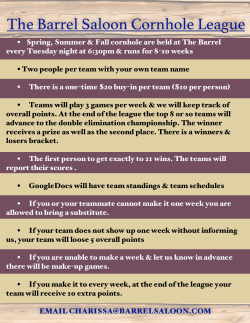
Current News Letter - League of Women Voters of Fremont, Newark
LEAGUE OF WOMEN VOTERS® FREMONT, NEWARK & UNION CITY May 2015 SATURDAY, MAY 9, 2015 Field Trip to Union Sanitary District OPEN HOUSE Talk to engineers, chemists, plant operators, mechanics, electricians, business services personnel, and more See USD's Greeen-Energy projects Please wear closed-toed, low-heeled shoes. Be prepared for walking and stairs Meet at League Office, 3375 Country Drive at 9:15 a.m. And Car Pool with League Members ANNUAL MEETING SATURDAY, JUNE 6, 2015 9:00 – 11:00 GUEST SPEAKER CONGRESSMAN MIKE HONDA Acacia Creek 34400 Mission Blvd Union City Breakfast ($13.50) Speaker Annual Meeting An evite will go out so you can pay online or let us know if you will attend. Prepayment is encouraged and puts your name in the drawing for a free membership for 2015-2016 BRINGING CLIMATE ACTION HOME FREMONT’S GREEN CHALLENGE MONDAY, MAY 11th Fremont Main Library 6:45 Meet & Greet 7:00 Program Rachel DiFranco Leading Fremont’s Climate Action Plan Implementation Co-Sponsor Alameda County Library PRESIDENTS’ MESSAGE BOARD OF DIRECTORS Officers Co-Presidents . VP Administration VP Program PRESIDENTS’ MESSAGE VP Voter Service Water continues to dominate the news. We explored the “In and Out of Water” at our last meeting in 2014 with a discussion with the Alameda County Water District and the Union Sanitary District. Members decided our League should have Water as an Issue for Emphasis at the Program Planning meeting in December. We continue exploring this area by encouraging members to go to the Union Sanitary District tour on May 9. Alice Johnson will meet people at LWVFNUC office at 9:15 AM to coordinate transportation to the site. The tour takes about 35-45 minutes and there will be refreshments! In addition to these meetings, Robert Monkman provided testimony to the Alameda County Water District Board asking them to consider encouraging developers of new building projects to add methods for recycling water. Secretary Treasurer Later this month learn about the City of Fremont’s Climate Action Plan in their attempt to win the Georgetown University $5 Million Energy Prize and how we can help. This meeting, co-sponsored by the Alameda County Library, will be held May 11th at 7:00 p.m. at the Fremont Main Library. Go to our website, www.lwvfnuc.org for more information on these meetings. Lastly be sure to save the date for our Annual Meeting on June 6th at Acacia Creek in Union City. We are excited Congressman Mike Honda will be our keynote speaker. We look forward to seeing you at the meetings and our Annual Meeting. Carolyn Hedgecock and Sam Neeman Directors Membership Voter Editor Communications At Large At Large At Large At Large Historian Membership Off Board Social Media Education Cmte. Chair Action Group, Chair Webmaster/Db Admin ` Membership Team Nominating Cmte. Sam Neeman Carolyn Hedgecock president@lwvfnuc.org Miriam Keller Ellen Culver program@lwvfnuc.org Mary Miller voterservice@lwvfnuc.org Judy Keller Peter Starr Sets Amann Alex Starr votered@lwvfnuc.org Open publicity@lwvfnuc.org Kathy Bray Alice Johnson Marsha Parker Evelyn La Torre Open Sets Amann Ann Crosbie Miriam Keller Alex Starr action@lwvfnuc.org Peter Starr webmaster@lwvfnuc.org Sam Neeman Kathy Steel-Sabo Lynn Locher Gail Blalock, Chair Andrea Schacter Pauline Weaver Published 10 times a year by the League of Women Voters of Fremont, Newark, and Union City (LWVFNUC) PO Box 3218 Fremont, CA 94539 Office: 3375 Country Drive, Fremont 510-794-5783 www.lwvfnuc.org Editor Alex Starr Layout Design: Jane Mueller, Well Chosen Words MAY 2015 / LWVFNUC 2 From Bay Area Monitor Taking Local Action on Climate Change By Alec MacDonald If you didn’t hear the news, maybe you felt it: 2014 was California’s warmest year on record, dating back to 1895. This revelation from the National Oceanic and Atmospheric Administration gave us yet another reason to sweat about our changing climate, following the agency’s 2013 announcement that the concentration of heat-trapping carbon dioxide in the atmosphere topped 400 parts per million for the first time in three million years. In explaining the significance of this unfortunate milestone, NOAA’s Pieter Tans told The New York Times, “It symbolizes that so far we have failed miserably in tackling this problem.” In the Bay Area, however, many people reject failure as an option, and they have been tackling the problem with vigor. In this undertaking, public policy has served as an indispensable tool. Motivated by recommendation of the California Air Resources Board, jurisdictions across this region have been working to slash their communities’ greenhouse gas emissions to keep pace with state reduction targets mandated by the Global Warming Solutions Act of 2006 (Assembly Bill 32). This means that by 2020, emissions must return to where they were in 1990, and by 2050, they must drop an additional 80 percent. It’s a tall order, but one that local governments have the power to fulfill. “Local governments are really uniquely capable of addressing a lot of the main sources of greenhouse gas emissions,” declared Timothy Burroughs, chief resilience officer for the city of Berkeley. “Local governments have land use authority that affects how and where things are built; we develop transportation infrastructure; we develop energy policies; we collect your solid waste and recycling.” How can jurisdictions leverage these responsibilities in order to cut emissions? Their most comprehensive option is to create a climate action plan. Lengthy documents that necessitate extensive preparation, climate action plans usually contain a few core components: an overview of relevant scientific principles, an inventory of community-wide emissions, a set of reduction targets, and a list of strategies for reaching those targets. Many also feature adaptation sections that propose ways for the community to protect itself from climate change’s inescapable impacts, which may strike in the form of sea level rise, drought, wildfire, or severe weather events, depending on the local landscape. Berkeley began to craft a plan after its voters approved Measure G, a 2006 ballot initiative that codified reduction targets for the city. Of the drafting process that ensued, Burroughs recounted, “We tried to create as many opportunities as possible for our residents and our businesses to engage in development of the plan, because we knew if the plan was to be implemented effectively, it really had to have support from the community.” This participatory endeavor culminated in 2009 with the city council’s adoption of the final plan, one of the first instituted in the Bay Area. Numerous jurisdictions followed suit, and now a total of 58 cities and counties — representing 80 percent of the region’s population — have plans in place, according to the Bay Area Air Quality Management MAY 2015 / LWVFNUC 3 District’s Abby Young. Her agency helped jumpstart many of the earlier plans (like Berkeley’s) with a round of grant funding in 2007, and has been guiding local governments through their drafting process. “We’re really excited and proud that the Bay Area has so many climate action plans,” she remarked of the region’s progress. “Pretty much every single city and county in the Bay Area, if they don’t have one, they’re developing one. So that’s pretty impressive.” Given the diversity inherent to the region, the evolution of each local government’s plan unfolds differently. Berkeley’s electorate backed Measure G’s reduction targets with 81 percent of the vote, an incredibly forceful public endorsement, even for a city with such a strong reputation for favoring environmentalism. Few other cities begin their climate action planning from such an advantageous position. Take Pleasanton, for instance. Daniel Smith, the city’s public works director, took the lead on drafting its plan. “I went out and did some research, and looked at other cities, and thought, ‘Well, this couldn’t be that hard to do,’” he recalled. At the time, he imagined the community would freely accept a slate of ordinances, but “that was definitely a little bit naïve.” After encountering significant stakeholder resistance, he said, “We stepped back and took a different approach.” The city tried to show flexibility and not come across as overbearing regulators, reaching out to business interests in particular. As a result, when the city council adopted the plan in 2012, those parties who had initially raised objection turned out to testify on its behalf. For example, Smith pointed out how the plan won over the local realtors association by eschewing a residential energy conservation ordinance. Commonly referred to as RECO, this kind of measure typically requires that a home meet certain energy efficiency standards before it can change ownership. Attaining these standards can mean costly renovations, bumping up the price of a home and theoretically driving away buyers. Realtors balked at this, so the city forged an alternative: after a home sale, it would offer the new owners assistance with boosting energy efficiency, familiarizing them with a range of upgrades, rebates, and tax credits for that purpose. The city hammered out similar arrangements regarding commercial properties as well. “The proactive, collaborative approach so far has done very well for Pleasanton,” Smith attested. The city released an update to the plan 15 months after its adoption, and “we were on track to meet our milestones and reach our 2020 goal.” If future updates indicate slippage, however, he said the city has the discretion to incorporate more regulation into the plan. Hardline environmentalists might argue for stricter upfront controls, especially when those controls have successful precedent (Berkeley implemented RECO way back in 1987, and its real estate market continues to hum along just fine). However, pragmatic climate action planning accommodates local realities. “There are a lot of people out there that want to do the right thing for the environment and help us become more sustainable, but there’s also the other side of it where they feel like you’re infringing on their freedoms,” Smith noted about Pleasanton. Alex Porteshawver, who serves as the city of Benicia’s consulting climate action plan MAY 2015 / LWVFNUC 4 coordinator, understands the value of bridging ideological divides. When attempting to move forward with policies, she suggested jurisdictions should “focus on co-benefits as a way to avoid polarizing the different groups who may have different viewpoints.” Safeguarding public health represents one objective that few people would oppose. Benicia’s climate action plan underscores authorities’ expectations that harsher heat waves and degrading air quality will exacerbate a range of maladies. The potential for an uptick in asthma rates poses special urgency, since the disease is already alarmingly prevalent among children in the vicinity and across Solano County. Porteshawver listed financial concerns as another big motivator, and spoke of how Benicia launched a program that allows businesses to trim their bills while reining in emissions. Under the program, the city provides businesses with energy use assessments, along with recommendations for improving efficiency. Such improvements might include lower-wattage lighting, solar Climate Change Two bills now in the California Legislature are critical to our continued efforts to mitigate climate change. SB 32 and SB 350 will extend current greenhouse gas emission reductions and petroleum reduction targets to 2050 and 2030 respectively. LWV California supports SB 32 and supports in concept SB 350 (see www.lwvc.org Bill Status Report for information). LWVBA is sponsoring a caucus at the LWVC Convention in San Diego, Saturday morning, May 16, 7:30 – 8:30 am. Join us to learn more about how to advocate for these important bills. installations, or fleet conversion to electric vehicles — upgrades the city can then help pay for with loans or grants. If these weren’t already enticing enough reasons to participate, hundreds of businesses who operate in the bustling Benicia Industrial Park can find extra incentive simply by looking out the window; the park’s shoreline location makes it vulnerable to sea level rise. Benicia’s program aligns closely to what Pleasanton has been doing in this sector, and on the whole, their climate action plans share much in common with each other’s and with Berkeley’s. For although the Bay Area is certainly diverse, its jurisdictions can still draw on many of the same policy solutions for reducing emissions and confronting the unifying threat of climate change. “No city can do this on their own,” Porteshawver concluded. “There are so many ways in which we don’t have to recreate the wheel, and we can work together.” Alec MacDonald is the editor of the Bay Area Monitor. PLUG IN TO CLIMATE ACTION The Bay Area Air Quality Management District and the Institute for Local Government host a web portal to climate action resources. Visit it at www.ca-ilg.org/sf-bay-area-climate-portal. MAY 2015 / LWVFNUC 5 LWV BAY AREA Bay Area Monitor Launches New Reporting Strategy In the summer of 2014, the League of Women Voters of the Bay Area Education Fund established its Water Education Initiative — a new project that was specially funded by water agencies, individual League members, and one local League. This allowed us to recruit journalist Robin Meadows as a reporting fellow for the Bay Area Monitor. In this role, Robin has been writing a series of six in-depth water articles that we have been publishing in Volume 40 of the Monitor. Robin’s series has drawn significant reader praise, and we have submitted it for an environmental reporting award. This summer, we are applying the fellowship structure to all of our coverage as a way to bolster our content and pay our writers a fairer wage. We have assembled a team of four talented journalists (Robin Meadows, Cecily O’Connor, Leslie Stewart, and Liz Devitt) to each cover a designated topic (water, transportation, air/energy, and open space) in Volume 41. We ask that you join us in supporting their important work with a financial contribution. Our formal fundraising campaign will begin soon, but if you would like to learn more now, please call 510-8391608 or e-mail editor@bayareamonitor.org. You can also check our website (www.bayareamonitor.org) for updates, or follow us on Facebook (https://www.facebook.com/bayareamonitor). LWVC Higher Education Study Submitted by Miriam Keller Our League is joining the LWVC state study on Public Higher Education in California. The scope of the study is accessibility: funding, affordability, preparedness, equity and opportunities & barriers for success. We will hold the first study session on Monday June 8, 2015 at 7:00 pm at the home of Miriam Keller. If you are at all interested in taking part in this study, please email or call Miriam Keller at 510-683-9377 or Miriamkel@comcast.net. The LWVC study committee website is http://lwvc.org/study/education-0. Many materials are available there to start the this study’s learning process. The study committee will begin with a review of the Little Hoover Commission report, A New Plan for a New Economy: Reimagining Higher Education (October 2013) accessible at:http://www.lhc.ca.gov/studies/218/report218.html New League members interested in higher education issues are strongly encouraged to join this committee. Miriam will introduce you to the process and guide you throughout. Some thoughts about possible questions that the committee might address: Why does the Little Hoover Commission recommend a new Master Plan? What are the economic and societal benefits of higher educaiton? Why does higher education need to improve? What is its purpose? Can higher education be more effordable? How? What are the barriers for success? How can we address them? Are studetns prepared adequately for higher education? If not, can that be addressed? MAY 2015 / LWVFNUC 6 (Date) (Event Name) (Time and Location) May 9 Field trip to Union Sanitary District Meet 9:15 a.m. League office to carpool May 11 Climate Action Meeting 6:45 Fremont Main Library May 18 Board Meeting 6:45 League Office June 6 Annual Meeting Acacia Creek June 8 LWVC Higher Education Study Meeting Miriam’s home ALL MEETINGS ARE FREE, OPEN TO THE PUBLIC AND WHEEL CHAIR ACCESSIBLE ANNUAL MEETING Mission The League of Women Voters of Fremont, Newark, and Union City, a nonpartisan political organization, encourages the informed and active participation in government, works to increase understanding of major public policy issues, and influences public policy through education and advocacy. Diversity Policy LWVFNUC affirms its commitment to reflect the diversity of our communities in our membership and actions. We believe diverse views are important for responsible decision making and seek to work with all people and groups who reflect our community diversity. Join the LEAGUE OF WOMEN VOTERS TODAY! Any person, man or woman, who subscribes to the purpose and policy of the League may join. To be a voting member, one must be at least 18 years of age and a U.S. citizen. Members under 18, or non-citizens, are welcome as non-voting Associate Members. Dues include membership in LWVFNUC, Bay Area League, and the California and National Leagues. Financial support for dues is available through our scholarship program. Contact Sets Amann, Membership Chair, for information. Name (s) _________________________________________________ _________________________________________________________ _________________________________________________________ New Member Renewal Transfer from ___________________________________________ Address __________________________________________________ _________________________________________________________ _________________________________________________________ Phone ___________________________________________________ E-mail ___________________________________________________ Please make your check payable to: LWVFNUC and mail it with this form to: LWVFNUC-MEMBERSHIP P. O. Box 3218 Fremont, CA 94539 Individual Membership—$60 Household Membership—$90 Donation to LWVFNUC $ __________________ Donation to Ed. Fund (Make separate check payable to LWVFNUC Ed Fund) $ __________________ Total Enclosed $ ________________ MAY 2015 / LWVFNUC 7 LWVFNUC P.O. Box 3218 Fremont, CA. 94539
© Copyright 2025









